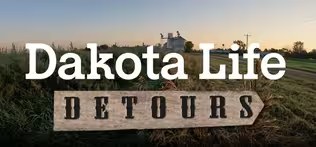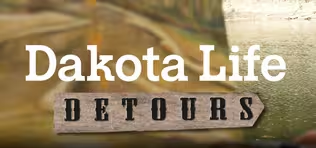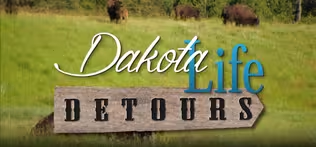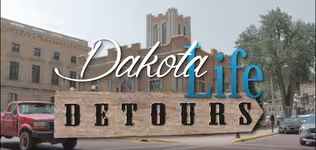Dakota Life
Dakota Life Detours Form Follows Function
Special | 23m 25sVideo has Closed Captions
What does it take to make a good saddle, pair of boots, and pottery? Skill and passion.
A good saddle is an important part of any South Dakota rancher, as is a pair of boots. Examine a saddle collection, what it takes to make custom cowboy boots, and pottery with spirit. We detour to Midland, Bushnell, and Wolsey.
Problems playing video? | Closed Captioning Feedback
Problems playing video? | Closed Captioning Feedback
Dakota Life is a local public television program presented by SDPB
Support Dakota Life with a gift to the Friends of Public Broadcasting
Dakota Life
Dakota Life Detours Form Follows Function
Special | 23m 25sVideo has Closed Captions
A good saddle is an important part of any South Dakota rancher, as is a pair of boots. Examine a saddle collection, what it takes to make custom cowboy boots, and pottery with spirit. We detour to Midland, Bushnell, and Wolsey.
Problems playing video? | Closed Captioning Feedback
How to Watch Dakota Life
Dakota Life is available to stream on pbs.org and the free PBS App, available on iPhone, Apple TV, Android TV, Android smartphones, Amazon Fire TV, Amazon Fire Tablet, Roku, Samsung Smart TV, and Vizio.
Providing Support for PBS.org
Learn Moreabout PBS online sponsorshipMore from This Collection
Dakota Life stories about South Dakota art and artists
Dakota Life Detours Forging Art
Video has Closed Captions
Using hands, brushes, hammers, heat, and molds, we visit artists of all sorts. (23m 54s)
Dakota Life Detours Pen and Ink
Video has Closed Captions
Putting “marks on paper” becomes art. A pen maker, a sketch artist, and an illustrator. (26m 6s)
Dakota Life Detours, Measure Twice
Video has Closed Captions
Cutting boards, canoes and guitars (27m 59s)
Dakota Life Detours Prayers, Sculptors, Scattered Joy
Video has Closed Captions
Go off the road to find examples of South Dakota determination. (27m 43s)
Providing Support for PBS.org
Learn Moreabout PBS online sponsorship- This is a production of SDPD.
Donors to the Explore South Dakota Fund support the production of local documentaries and other programs of local interest presented by SDPB.
Friends of STPB appreciates their support of this program.
- Welcome to Dakota Life Detours.
As you can see, South Dakota is a vast state covering over 77,000 square miles.
About half of that is the rolling short grass prairie of Western South Dakota.
Here.
Ranching is an integral part of this grasslands economy and a way of life.
In this episode of Dakota Life, we will look at the craftsmen who create two essential ranching tools, saddles and boots.
But first we take you to the State's eastern side to meet pottery artist Dave Hubner of Bushnell.
Dave started as an engineering student at SDSU, but as a version to math and his creative spirit led him to pursue his passion and profession.
- I tell people I'm semi-retired.
I'm down to about 80 hours a week.
When I was a little kid, I had to make my own toys.
And you can see I'm still making my own toys.
I'm David Hubner, live in Bushnell, South Dakota.
Step into my studio.
I I actually grew up in Florida and I was big with the Seminoles and stuff down there, but then I got a one-Way bus ticket to South Dakota State University 'cause my father wanted to go there, but he got thrown off the farm 'cause he planted some hybrid seed corn and his father wasn't gonna have any of that nonsense on his farm.
So he joined the Army and they sent him to Orlando where I grew up.
He always wanted to go to South Dakota State and be an engineer.
So he gave me a one-Way bus ticket.
And I sold my 1955 Chevy that I had rebuilt and restored for $500 and it paid for two semesters of college.
Then started out taking engineering, but then I wasn't very good at mathematics, so I switched to art.
I actually painted my way through college painting highway billboards, but I also took a film production class and I had to go do some animations.
And the first one I did was a, a turtle looking for a shell.
And I got a new shell with curtains and doors.
And, and then the second animation that I did, I went to the ceramic studio and single framed a lady making little VAEs and I got bit by the bug or whatever.
I don't, to me, pottery is more of a disease I get.
I go nuts if I don't have clay in my hands.
And I moved to Bushnell, South Dakota in 1977.
It was an accident.
I was driving through town at 11 o'clock at night coming from an art show in Minneapolis.
And for some reason I decided to drive through this town and there was a, a streetlight on in front of this old abandoned store.
And I had seen a pottery shop in Minnesota that had bought an old store and were operating there.
So we came back and bought the place for $3,000 on Main Street in Bushnell.
I do a lot of stuff for museums that I make stuff for, like the prehistoric Indian Village in Mitchell.
They can't sell what they dig up 'cause most of it's broken.
And usually if you find a whole piece of the pottery that was made here five, 600 years ago, it would be grave goods and have to be turned over to the Native American tribe.
So what I do is reproduce the, what they dig up and glue back together.
It's an interesting story how it got into Buffalo.
I did kind of drippy splattery stuff.
And then one day the Smithsonian called and said, can you make a mug with a buffalo on it?
We're having a, a show on the mall and we want pottery from every state in the union.
And we want something in South Dakota with a buffalo.
I have about 20 different time periods and programs that I'm capable of doing or have done.
I do, I was a topographic engineer for the United States Army in the Corps of Engineers.
And so I do a lot of programs on engineer explorers.
John c Fremont, Zebulon Pike, Merriweather Lewis.
I never really got into art till I was in college.
I, in, in high school.
I took engineering, drawing, mechanical drawing sheet metal drawing per as a engineering aspect of it, which when you get into art, I mean when to, to pass drawing class, I had to draw.
Left-handed one eye closed to get a grade because I'm used to drawing interlocking gears and that kind of stuff.
And I had to free up as the teacher said I was too tight.
I don't know.
I've always been interested in history and I collect pottery from and do programs on, well, the first pottery around here was at new home, the 1858.
They brought in potters to, to make beer bottles for the Shells brewery.
Other than a few scraps of papyrus and some stone work, they, they date it by the type of pottery that was made.
A lot of poor families only had one cup for the whole family.
And the tig well, you'd take the tig, you go to your tavern and order a, a pint of rum, a hot buttered rum.
Well, the ma the tavern owner would go over to the fire and pull out a red hot iron and shove in your beverage to heat it up, called a mulling iron, and then to pass a cup.
They hadn't invented germs yet, so you, you pass a cup and you got multiple handles.
Well, from the poem, four and 20 pie birds baked in a pie.
When the pie was done, the birds began to sink.
They used to insert a pie, bird in the pie.
Instead of cutting slits in the top like we do today, they insert a pie bird.
And so the steam comes up through the base and goes out the beak.
These are traditional shapes where just the head of the bird would stick out of a, and this is a replica from Cahokia, the black drink, the, the Eastern ceremonial Mound building culture drink.
Something called the black drink for before ceremonies.
It was from the Yukon Holly.
And it's got nine times more caffeine than, than a coffee bean.
I tell people I'm, I'm more of a ceramic contractor anymore.
I've got hundreds and hundreds of mugs.
My work is heavily influenced by history and the plains culture.
It's made out clay, I'm interested in it.
- Dave is a traditional stone wear potter who works with both new and old forms.
He says the only constant in his work is change.
Ranchers say a necessary constant in their work is a good saddle.
Ralph Shorty Jones shows us his collection.
And saddle maker Irvin Jones discusses what makes a good saddle.
- This is my old hamley that I ordered in 1958 and that I rode several saddles in between.
That cost me $265 when I bought it.
And that was quite a decision to make in 1958.
Whether you could afford to give $265 for a new saddle.
My dad was a stickler on when you got done, you took care of your horse first, and along with taking care of your horse, you took care of your saddle cowboys that worked on the open range.
You, they were in there saddled 12 hours or maybe 16 hours in a day a lot of times.
So you didn't just throw it in the ground and walk off and leave it.
You took care of it.
- That was their living, you know, they used it to work with and that's what they made money, especially a hired man or something like that.
You know, he'd always have a good saddle.
Maybe he'd sacrifice something else to have a good saddle.
And then the guy he was working for, he, he needed to have a, have the guy have a good saddle so he didn't hurt his horses or didn't do this and that back in the day, you know, - That was probably the most important tool of your trade.
It probably took several months wages to, to buy a decent saddle.
- My dad always told me it took three steer calves to buy a saddle.
Well, right now that'd be pretty good money, you know, but you take a look at it at, at certain times it was pretty, it was about right.
- You know, there there is an old Western song about $10 horse and a $40 saddle.
And that's probably kind of right on a $10 horse and a $40 saddle.
I'm going to punch them.
Texas, his cattle, - My brother-in-Law wanted a Harley Davidson saddle.
So here we are.
If the guy was gonna be ranching and riding for somebody, you had to have a good tack and stuff had to be pretty good.
Or else you just break down.
It wasn't any good, you know.
- Well, you're a foot then and you know, if you can get by without some of the other things, but if back before you had a car or anything, that's the only way you got around.
And a cowboy without a saddle.
I don't think many ranchers were very interested in hiring him to be at the, the breakfast table every day and, and not have a saddle.
Tom Berry is my maternal grandfather.
They ranch south of Belvedere and we visited back and forth a lot when I was born.
He was the governor.
My mother and I went to the governor's mansion for her to recuperate from the hospital.
Well, I always say that was my claim to fame.
Yeah, I guess it was probably after his death and my mother had the saddle and after I started collecting saddles, well they thought that that was a good place for it to be was with that collection.
Yeah, this is the EC lee saddle that Tom Berry saddle was given to him while he was governor.
Probably one of the fancier saddles that EC Lee made.
You know, it has a rope binding look on the cattle and, but you can see that it's been rode a lot.
I rode it a few times, you know, and it was still a good use in saddle at that time.
So - When you see a saddle, I like stories, you know, it's the quality of the saddles, it's the carbon on 'em, you know, way they're made, you know, and the repetition back and when they were made and that certain era, you know, that's kind of what you look at when you just look at several saddles, you know, you kind of pick them up on it a little bit, you know?
Yeah, that's pretty good, you know, this and that and, and, but the older ones are a lot of good ones.
You know, lot of good old saddle makers, but not too many rich ones.
- You know, I don't take the big outside circle anymore.
But yeah, I ride quite a lot horseback yesterday and Tuesday and Wednesday I was horseback and probably gonna be horseback tomorrow.
Life's been really good to me.
And I guess at my age, and I can still saddle my own horse ride off that, that gives me a lot of satisfaction.
Now I have to cheat a little bit here anymore in my old age, I do admit that if one of the boys is in the barn when I'm saddling up, they usually throw it on for me.
But, but I still do it myself too.
Not too graceful anymore, I would think.
When you think of a cowboy, you just think with his horse, and of course he has to have a saddle know they're almost one and the same - As shorty said, a cowboy needs a horse and a saddle.
Two very important tools along with a good horse and a good saddle.
A good pair of boots is vital.
We travel next to Woolsey and visit boot maker Mark Schumacher to gain insight on what goes into making a great pair of boots.
- The cobblers were always the shoe repair guys.
Maybe way back when, you know, centuries ago the cobbler was the guy that made the shoes, but anymore it got more of a meaning of the shoe repair guy.
My name is Mark Schumacher.
We're in Woolsey, South Dakota.
Step into my studio.
I usually call it a shop.
I am basically kind of an all around leather worker.
How I got started in the, in the leather deal.
It was just something that I wanted to do pretty much started when I was a kid.
You know, you could get kits from Tandy Leather company at that time, it was in the seventies when I was fairly young, yet when I was about 10 years old.
And in Howard County, in the state of Iowa, the pocket gophers were, had a 25 cent bounty on them because they dug up and they'd the mounds and stuff like that.
And hindered a lot of farming and what have you.
So I trapped pocket gophers until I made enough money to buy my leather kit that I wanted.
I had worked several different jobs, including packing houses, jobs and things like that.
And I had an opportunity to go learn how to build boots.
So I went to learn how to build boots and when I came back, I just went to building boots.
So, you know, you just have to get up every day and go do it.
You know, that's all there is to it.
I knew I was versatile.
I knew I could do several things.
I'd made, I don't know how many belts and billfolds and things like that all the way through college.
I actually made all my spending money on belts and billfolds and, and selling them to other college kids, you know, at that time.
So I knew I could do the work.
I knew I, I could make something happen.
Here we're gonna put a state seal.
Skyping is just a, basically a cut that you make on the edge.
If you are working wood, you call it a, maybe a, a champer, but a sky, basically what it does, it, it makes your joints a lot nicer.
It finds up your leather just a little bit.
So you go from full thickness down to a feather edge when you're fitting a boot on it to person, You gotta remember the human foot's a moving breathing thing.
Leather at one time was a moving, breathing thing.
That's probably the, the most challenging part of making boots Leather has memories, which is very helpful in this occupation because once you wear the boot and you get the boot broke in, the leather will remember your foot.
Basically.
My job is to make it as comfortable as possible in a static position.
The fit is always, always, always comes right back down to what the customer feels it is.
In order to get your tops kind of finished off and stuff and make 'em look nice, you put a little beading on them.
When I started out, I started out at home.
I had a little chicken coop, then we took and we put some insulation in the walls and, and sheet rocked it the inside of it and made it so that you could heat it and cool it with little or nothing, you know, and it got started there.
And then I was, the chicken coop was kind of small, so I didn't have room for everything that I wanted or needed to, to do the business, you know, so this here came up for rent and I come up to town here and I rented it for I suppose four years or so.
And then I finally bought it.
We build everything.
We build work boots, we build lace up boots for guys that can't get a fit anywhere else.
There's some guys that are capable of doing it, but they don't pursue it full time.
There's a variety of different leathers out there, you know, from exotic skins, opr skin elephants.
We buy basically chrome tan leather and then we build, build out of that leather.
So manufacturing leathers a whole, whole nother art in itself.
I'm probably the, the only full-time, most active boot maker in the state.
I'm usually the guy they call.
I've done business with people from all 50 states.
Build a lot of bull hide boots for, for people in the state here because they want a boot that they can wear for dressing, casual wear for a while, and then eventually they got a gold work in it, you know, so they got them, get as much use out of a boot as they can.
It's not uncommon for a boot that I build to, to last 10 years, five, 10 years, 15 years.
I've even seen some come back in here that were 20 years old, but they wore and they fixed and they wore and they fixed.
It's like any carpenter will tell you, you know, if you know how to fix your mistakes, you're a pretty good carpenter.
If you can't fix your mistakes, well you're not maybe quite as good a carpenter as what you think you are.
You know?
So you don't gotta know how to fix your mistakes.
But you also, you gotta know when to quit the program and, and start over too.
One thing about leather, like with you're stitching leather, you're poking holes in leather, of course you stitch it, you don't make any mistakes because if you do well, number one, you can really, really see it.
And number two, there's no going back and doing it over again and making it straight or, or, or trying to fix it.
It's the same difference as a big nitten, but a little harder on the bottom.
A good pair of boots is priceless.
- The South Dakotans we've introduced you to are all artists, whether it's making boots, crafting saddles, or creating pottery.
All three forms are functional.
It's a South Dakota trait to be an artisan who creates art with a practical use.
As we continue our travels across South Dakota, meeting folks and telling their stories of Dakota life, we will take you to more detours along the way and share those stories of our state's heritage, culture, and way of life.
And for all of us at SDPD, I'm Tim Davison.
Thank you so much for watching.
Support for PBS provided by:
Dakota Life is a local public television program presented by SDPB
Support Dakota Life with a gift to the Friends of Public Broadcasting

















